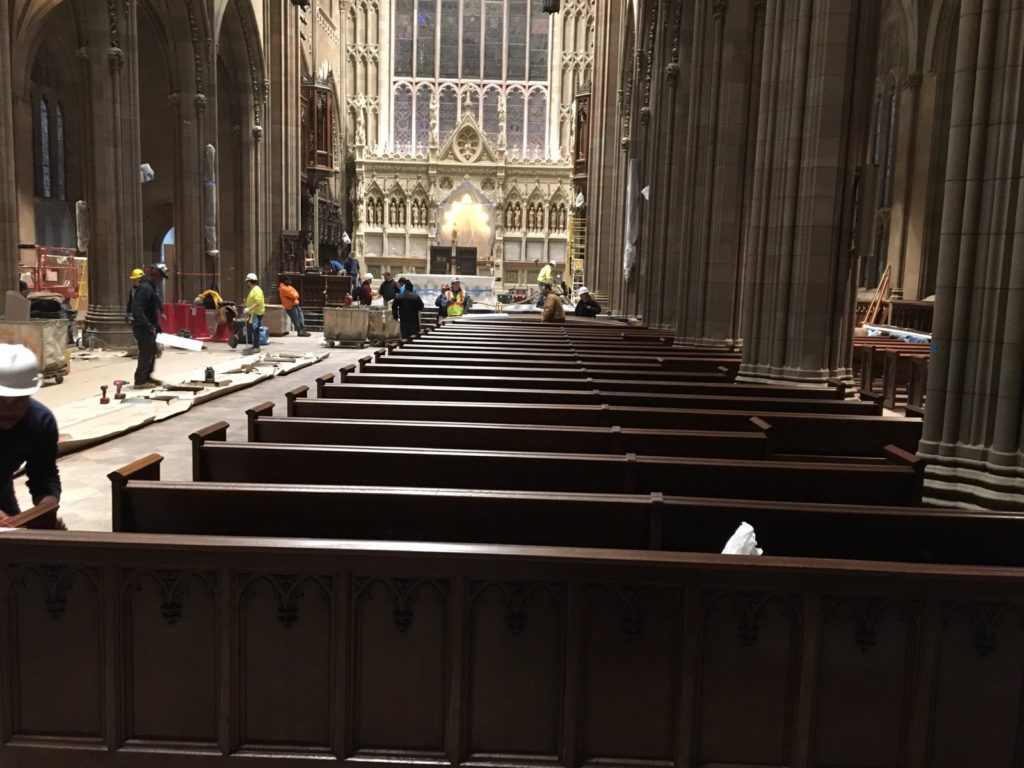Trinity Church Wall Street is an active Episcopal Parish that has been an integral part of New York’s history for more than three hundred years.
The church has not undergone a major restoration project since the 1940s.
Planning began in 2014 for the restoration project that would include all elements of the church property. This included interior and exterior restoration to the building, and many improvements to the historical grounds surrounding the church proper.
Of major importance to the church interior was restoring the over one hundred year old pews to fit today’s parishioners changing sizes, along with refinishing to make them look and feel as they did when originally installed. Many new comfort features were also incorporated into the project.
The original pew ends and backs were extremely high, while the seats were flat and short. The pews needed much more support, especially when it was deemed necessary to remove the divider wall, which did not permit parishioners to slide through.
After much thought and cooperation with the historical consultants and architects, The Keck Group offered a variety of solutions which were ultimately put to the task.
First, the ornate ends were completely disassembled, the panels cut down in such a way as there were no cross cuts to be observed, and then put back together as if by magic.
Next came the seats. It was determined that the fourteen-inch wide seats were no longer appropriate. In addition, they were flat. Keck personnel designed a new sixteen-inch contoured seat which was re-routed into the now modified lower ends. Because all of the existing pew parts were manufactured of white rift-cut oak, all of the new pieces had to be of the same species. Although the backs existed as a two-piece, we decided to go with a single-piece seat, while the hack halves were neatly fit into a new Keck designed joiner. This is the first time a single-piece seat had been fitted into a joiner with a two-piece back.
The backs were then cut down six inches and modified to fit the lower ends. This totally new design, lowering the backs and ends, bought the pews into the 21st century.
New joiners as described above replaced the inhibiting divider wall that went from front to rear in the center section pews. We added new mid supports and double cleated the joiners and mid supports, while attaching a single cleat at the pew ends. This helped to stabilize the wider seat and strengthen the whole pew.
Finally we added custom finished Atwood Hamlin light-weight kneelers to replace the old wood kneelers and hassocks.
As instructed, many of the new parts were built from salvaged wood not being used. The new hymnal racks, for example, were made from the old angled top mounted racks.
Matching old with new created quite the challenge, especially when trying to stain the sixteen foot long seats evenly. New wood takes stain much differently than wood that has the finish removed, so it was a process with many eyes watching to make sure all colors matched and were even.
Finally came the installation!
Instead of the four weeks allotted to install both the refinished/modified wainscot and pews, the installation period fell to two weeks. Here is a picture of the work force on the day of our arrival.

More than one hundred men working at a feverish pitch trying to make the impossible happen – turning the church over for Christmas.
We offer many thanks to the Construction Manager, Sciame Construction, who helped pull it all together. They made each request available to us for the wainscot install, followed closely by the pews. We finished the project on Friday, December 20th at 6p. when all workers tools, lifts and materials had to be removed from the church. Attachment of the kneelers to the wainscot followed shortly after.
A great celebration for all of us who worked so hard to make this happen and arrive at the finish line in time for the holidays!
Additional Photos:






Page updated on October 13, 2021

